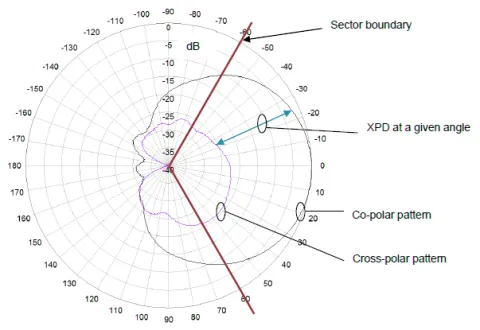The following article serves to build an understanding about the antenna parameter known as Cross-Polar Discrimination (XPD). Cross-polar discrimination is important for a low level of correlation between the orthogonally polarized propagation channels. Correlation generated by the antenna can negatively affect receive diversity and MIMO downlink performance of the system.
For cellular and multipoint antennas, Powertec recommend a minimum level of 8 to 10 dB within the relevant sector or beamwidth for minimum degradation to receive diversity and MIMO performance. The requirements for microwave antennas are significantly higher (20 to 30 dB), with minimum figures specified depending on the antenna's ETSI Radiation Pattern Envelope (RPE) Class (see ETSI EN 302 217-4-2).
In simpler terms, XPD measures an antenna's ability to reject signals that are orthogonally polarised, ensuring a cleaner signal particularly in co-located environments.
Definition of Cross-Polar Discrimination
The cross-polar discrimination is defined as a ratio of the co-polar component of the specified polarisation compared to the orthogonal cross-polar component over the sector or beamwidth angle.
Specification Definition
When disclosing cross-polar discrimination on test reports and datasheets, Powertec follow the BASTA reporting recommendations. BASTA define the reporting of XPD per the following specification. As BASTA is limited in scope to base station antennas, specification definition has been broadened to cover other directional antenna types, such as microwave antennas.
- Cross-polar discrimination is the magnitude of the relative power of the cross-polarised pattern with respect to the co-polarised pattern at a given angle
- Cross-polar discrimination over the sector/beamwidth is the minimum value measured in a defined ± angular deviation from the main beam direction. The specified sector or beamwidth must be noted (i.e., ± 60°).
- Recommended measurement angle is the sector angle (for sectoral/panel antennas), or twice the half power beamwidth for highly directional antennas (per ETSI EN 302 217-4-2).
- It is subject to a statistical validation for a single-sided parameter.
- The industry accepted abbreviation for cross polar discrimination is XPD.
- This parameter is to be defined for the nominal subbands in a broadband antenna. Unless otherwise noted it will be assumed the specification is for the full electrical downtilt range (where applicable), and for all the ports associated with each frequency subband of the antenna (where applicable).
Testing & Reporting
Cross-polar discrimination is calculated through measurement and comparison of the antenna co-polar and cross-polar radiation pattern. The co-polar radiation pattern is measured by rotating an actively transmitting antenna inside an anechoic chamber, and measuring power levels at set intervals using a receive antenna of the same polarity.
Cross-polar patterns are measured in the same manner, but using a receive antenna of the orthogonal polarity. A minimum figure is then obtained within a defined sectoral or beamwidth boundary. It is important that this boundary angle be disclosed on the antenna datasheet.

References
NGMN, "Recommendations on Base Station Antenna Standards", NGMN Alliance, N-P-BASTA v11.1, Mar. 2019.